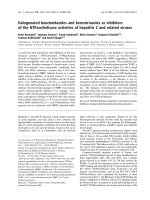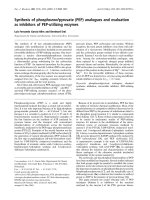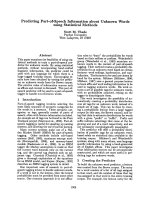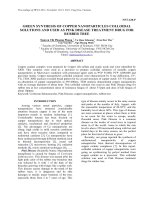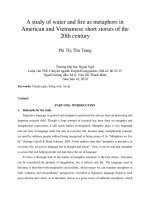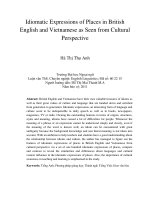Short sellers and analysts as providers of complementary information about future firm performance
Bạn đang xem bản rút gọn của tài liệu. Xem và tải ngay bản đầy đủ của tài liệu tại đây (590.08 KB, 92 trang )
SHORT-SELLERS AND ANALYSTS AS PROVIDERS OF COMPLEMENTARY
INFORMATION ABOUT FUTURE FIRM PERFORMANCE
A Dissertation
by
MICHAEL STEPHEN DRAKE
Submitted to the Office of Graduate Studies of
Texas A&M University
in partial fulfillment of the requirements for the degree of
DOCTOR OF PHILOSOPHY
May 2009
Major Subject: Accounting
UMI Number: 3370690
INFORMATION TO USERS
The quality of this reproduction is dependent upon the quality of the copy
submitted. Broken or indistinct print, colored or poor quality illustrations and
photographs, print bleed-through, substandard margins, and improper
alignment can adversely affect reproduction.
In the unlikely event that the author did not send a complete manuscript
and there are missing pages, these will be noted. Also, if unauthorized
copyright material had to be removed, a note will indicate the deletion.
______________________________________________________________
UMI Microform 3370690
Copyright 2009 by ProQuest LLC
All rights reserved. This microform edition is protected against
unauthorized copying under Title 17, United States Code.
_______________________________________________________________
ProQuest LLC
789 East Eisenhower Parkway
P.O. Box 1346
Ann Arbor, MI 48106-1346
SHORT-SELLERS AND ANALYSTS AS PROVIDERS OF COMPLEMENTARY
INFORMATION ABOUT FUTURE FIRM PERFORMANCE
A Dissertation
by
MICHAEL STEPHEN DRAKE
Submitted to the Office of Graduate Studies of
Texas A&M University
in partial fulfillment of the requirements for the degree of
DOCTOR OF PHILOSOPHY
Approved by:
Chair of Committee,
Committee Members,
Head of Department,
Senyo Tse
Ekkehart Boehmer
James N. Myers III
Lynn L. Rees
James J. Benjamin
May 2009
Major Subject: Accounting
iii
ABSTRACT
Short-sellers and Analysts as Providers of Complementary Information about Future
Firm Performance. (May 2009)
Michael Stephen Drake, B.S., Brigham Young University;
M.Acc., Brigham Young University
Chair of Advisory Committee: Dr. Senyo Tse
This study examines whether short-sellers and financial analysts develop
complementary information about future earnings and returns and assesses whether
investors can improve predictions made by each of these intermediaries using
information provided by the other. The first main result is that the relative short interest
ratio (shares sold short divided by total shares outstanding) contains information that is
useful for predicting future earnings, beyond (i.e., incremental to) the information in
analyst forecasts. I also find that analysts do not fully incorporate short interest
information into their forecasts and demonstrate that analyst forecasts can be improved
(i.e., can be made to be less biased and more accurate) by adjusting for short interest
information. The second main result is that analyst forecast revisions contain
information that is useful for predicting future abnormal returns, beyond the information
in the relative short interest ratio. I demonstrate that portfolios of stocks formed based
on consistent signals from short-sellers and analysts produce abnormal return spreads
that are significantly larger than spreads produced by portfolios formed using signals
iv
from short-sellers alone. Collectively, the evidence suggests that short-sellers and
analyst provide complementary information about future firm performance that is useful
to investors.
v
DEDICATION
To my father, Terrance Stephen Drake, the “real” doctor in the family.
vi
ACKNOWLEDGEMENTS
I thank my committee chair, Senyo Tse, and my committee members, Ekkehart
Boehmer, Lynn Rees, and James Myers for their guidance and support throughout the
course of this research. I also thank Ed Swanson for sharing his short interest data and
Anwer Ahmed, Kris Allee, Cory Cassell, Linda Myers, Stephanie Rasmussen, Jaime
Schmidt, Nate Sharp, Anne Thompson, Jake Thornock, Chris Williams, Rebecca
Wynalda for helpful comments. I also want to extend my gratitude to the Mays Business
School and the Deloitte & Touche Foundation for generous financial support. Finally,
thanks to my wife, McKenzie, and my children, Gavin and Abbie for their love,
patience, prayers, and humor.
vii
TABLE OF CONTENTS
Page
ABSTRACT ..............................................................................................................
iii
DEDICATION ..........................................................................................................
v
ACKNOWLEDGEMENTS ......................................................................................
vi
TABLE OF CONTENTS ..........................................................................................
vii
LIST OF FIGURES ...................................................................................................
ix
LIST OF TABLES ....................................................................................................
x
1. INTRODUCTION ...............................................................................................
1
2. LITERATURE REVIEW AND EMPIRICAL PREDICTIONS ........................
8
2.1.
2.2.
2.3.
2.4.
2.5.
Background on Short-Selling ...............................................................
Relevant Literature on Short-Selling....................................................
Relevant Literature on Financial Analysts ...........................................
Motivation ............................................................................................
Empirical Predictions ...........................................................................
8
10
16
19
20
3. SAMPLE SELECTION, VARIABLE MEASUREMENT, AND
DESCRIPTIVE STATISTICS ............................................................................
24
3.1. Sample Selection and Variable Measurement ......................................
3.2. Descriptive Statistics ............................................................................
24
26
4. EMPIRICAL MODELS AND RESULTS ..........................................................
34
4.1. The Incremental Information Content of Short Interest
for Future Earnings beyond Analyst Forecasts ....................................
4.2. Assessing Analyst Efficiency with Respect to Short Interest ..............
4.3. Adjusting Analyst Forecasts for Short Interest ....................................
4.4. The Incremental Information Content of Analyst Forecast
Revisions for Future Returns beyond Short Interest ............................
34
47
54
57
viii
Page
5. CONCLUSION ...................................................................................................
70
REFERENCES ..........................................................................................................
74
APPENDIX A ...........................................................................................................
79
VITA .........................................................................................................................
81
ix
LIST OF FIGURES
FIGURE
Page
1
Mean and Median Relative Short Interest Ratios over Time .....................
10
2
Timing of Variable Measurement ..............................................................
27
3
Mean and Median Future Accounting Profitability across
Relative Short Interest Ratio Portfolios .....................................................
35
Six-Month Abnormal Returns to Portfolios Formed Using Short
Interest or Short Interest and Analyst Forecast Revisions .........................
62
4
x
LIST OF TABLES
TABLE
Page
1
Descriptive Statistics ..................................................................................
28
2
Transition Matrix for Changes in Short Interest Portfolio
Membership over the Next Two Quarters ..................................................
32
The Association between Short Interest and Quarter-One Earnings
with and without Controlling for Analyst Forecasts ................................
40
The Association between Short Interest and Quarter-Two Earnings
with and without Controlling for Analyst Forecasts ..................................
45
The Association between Short Interest and Quarter-One and
Quarter-Two Forecast Errors .....................................................................
50
Comparisons of Error and Squared-Error of Unadjusted Analyst
Forecasts to Forecasts Adjusted with Short Interest Information ..............
56
The Association between Analyst Forecast Revisions and Subsequent
Abnormal Returns with and without Controlling for Short Interest ..........
60
Abnormal Returns to Portfolios Formed Using Short Interest or
Short Interest and Analyst Forecast Revisions ...........................................
61
Four-Factor Regression Results for Portfolios Formed Using
Short Interest ..............................................................................................
66
Four-Factor Regression Results for Portfolios Formed Using
Short Interest and Analyst Forecast Revisions ...........................................
68
3
4
5
6
7
8
9
10
1
1. INTRODUCTION
Short-sellers are informed investors who take positions in firms whose stock
price they expect to underperform in the future. Since short-sellers profit by anticipating
stock price declines, they are broadly labeled by the financial press as “bears” or
pessimistic investors. In contrast, financial analysts are generally characterized as being
overly optimistic about future stock and earnings performance.1 While extensive
research investigates financial analysts role as information intermediaries, recent
research takes initial steps at examining the potential role of short-sellers as information
intermediaries in the capital markets (Pownall and Simko 2005; Akbas et al 2008). The
objective of this study is to investigate whether short-sellers and analysts develop
complementary information about future firm performance and to assess whether
investors can improve predictions made by one intermediary by using information
provided by the other.
I investigate short-sellers and analysts because they both predict future firm
performance and because their incentives make it likely that they develop different types
of value-relevant information. Short-sellers seek to profit from their predictions of stock
price declines. Analysts predict earnings and must balance incentives to make accurate
predictions with incentives to maintain relationships with management (Francis and
This dissertation follows the style of The Accounting Review.
1
This characterization is based on the distributions of stock recommendations, which prior research finds
to be heavily skewed towards “buy” and of analyst forecast errors, which prior research finds to be
negative on average. See, for example, Abarbanell (1991), Ali et al. (1992), McNichols and O’Brien
(1997), Easterwood and Nutt (1999), and Bradshaw et al. (2001).
2
Philbrick 1993; Lim 2001).2 These differences suggest that short sellers and analysts
uncover unique information and that investors may be able to infer incremental
information about future performance from each intermediary. The similarities and
differences between short-sellers and analysts motivate my two research questions.
My first research question is whether short interest positions contain information
that is useful for predicting future earnings, beyond the information available from
analyst earnings forecasts. Extant research suggests that short-sellers are informed about
future stock price movements (Diamond and Verrecchia 1987; Asquith and Meulbroek
1996; Dechow et al. 2001; Desai et al. 2002; Asquith et al. 2005; Boehmer et al. 2008).
The information used by short-sellers to predict returns is also likely to predict earnings
because short-sellers may discover information related to future earnings news that other
market participants do not have or short-sellers may uncover price-relevant information
on events that will be reflected in current or future earnings (Collins et al. 1987;
Warfield and Wild 1992).3 However, analyst forecasts may not fully reflect information
from short-sellers. Analysts may be reluctant to damage relationships with management
by updating their forecasts with pessimistic information (Francis and Philbrick 1993;
Lim 2001), and they may under-react to the information because they view short interest
as an unreliable signal about future earnings (Abarbanell 1991; Abarbanell and Bernard
2
Issuing earnings forecast is just one of a group of services that sell-side analysts provide to their clients
(e.g., they also issue stock recommendations, target prices, and growth forecasts). I focus solely on
earnings forecasts because one of the objectives of my study is to investigate whether short-sellers and
analysts develop complementary information about future earnings.
3
For example, a short-seller might take a short position based on information about the future product
recalls. Here, the negative stock price reaction at the time of the recall announcement will occur before
the earnings effects of the recalls are recognized.
3
1992). If the short interest information is not fully subsumed by analyst forecasts, then
investors could improve the accuracy of those forecasts by incorporating short interest
information.
My second research question is whether analyst earnings forecasts (i.e., forecast
revisions) contain information that is useful for predicting future abnormal returns,
beyond the information available in short interest. Short interest positions reflect shortsellers’ predictions of future stock price performance. In contrast, analysts’ earnings
forecasts focus on reported earnings, and are not intended to predict returns.
Nevertheless, prior studies find that analyst forecast revisions are positively associated
with subsequent returns (Mendenhall 1991; Stickel 1991; Chan et al. 1996; Shane and
Brous 2001; Barth and Hutton 2004), which suggests that analyst forecast revisions can
be used to predict future returns. Thus, I also examine the extent to which forecast
revisions contain information that is incrementally useful for predicting future returns by
testing whether short interest fully subsumes the information in analyst forecast
revisions. If the information in forecast revisions is not fully subsumed by short interest,
then investors could improve their returns predictions using short interest by
incorporating information provided by financial analysts.
I address my research questions using a large sample of monthly short interest
data from 1988 to 2002 for firms listed on the New York Stock Exchange (NYSE), the
American Stock Exchange (AMEX), and NASDAQ Stock Exchange. My short interest
variable is the relative short interest (RSI) ratio, calculated as shares sold short divided
by total shares outstanding. My analysis is based on two sets of empirical tests.
4
The first set of tests investigates whether short interest positions contain
information that is useful for predicting future earnings, beyond the information in
analyst forecasts. I find that the RSI ratio is negatively associated with earnings levels
and changes disclosed in the next two quarterly earnings announcements, which I label
“quarter-one” and “quarter-two” respectively.4 These associations hold after controlling
for the information in the consensus analyst forecast, prior period earnings, prior period
returns, and various firm characteristics (e.g., size, book-to-market). I also find that the
strength of the association between the RSI ratio and earnings levels and changes are
statistically equivalent in quarter-one and quarter-two. This evidence is consistent with
short-sellers’ use of information that predicts earnings, and with that information not
being fully embedded in the consensus earnings forecast.
I also find that the RSI ratio is negatively associated with analyst forecast errors
(actual EPS minus forecast EPS) in quarter-one and in quarter-two. This result is robust
to controls for variables that prior studies find to be significantly associated with
forecasts errors and suggests that analyst forecasts do not fully reflect short interest
information. Third, I demonstrate that consensus analyst forecasts can be improved by
adjusting the forecasts for information in short interest about future earnings.
Specifically, I adjust current-period analyst forecasts using the historical relationship
between RSI ratios and analyst forecast errors. I find that adjusted consensus analyst
4
I focus on the two earnings announcements subsequent to the short interest measurement date because
although examining the association between short interest and quarter-one earnings is the natural starting
point, changes in prices generally lead changes in earnings (Collins et al. 1987; Warfield and Wild 1992).
Thus, I also examine quarter-two earnings. This allows me to investigate whether any associations hold
over a longer earnings horizon.
5
forecasts are significantly less biased and more accurate than are the raw consensus
analyst forecasts.
The second set of tests investigates whether analyst forecast revisions contain
information that is useful for predicting future abnormal returns beyond the information
in short interest. I find that analyst forecast revisions are positively associated with
abnormal returns over the six months following the forecast revision date, after
controlling for the information in the RSI ratio and for other common risk factors (i.e.,
size, book-to-market, momentum).5 This suggests that analyst forecast revisions contain
information that is incrementally useful for predicting future returns, beyond the
information in short interest.
Next, I demonstrate that portfolios of stocks formed based on information from
both short-sellers and analysts produce larger spreads in future abnormal returns than do
portfolios of stocks formed based on information from short-sellers alone. Specifically,
I find a nearly monotonic negative relationship between portfolios of RSI ratios and
future abnormal returns. The lowest portfolio of RSI ratios earns significant abnormal
returns of 3.0% over the following 6 months, while the highest portfolio earns significant
abnormal returns of -3.7% over the same period, resulting in a return spread of 6.7%.
When I partition each short interest decile into three portfolios based on the sign of the
consensus analyst revision (i.e., positive revision, no revision, or negative revision), I
find that the return spread between portfolios formed based on consistent signals is
larger than the return spread based on short interest alone. Specifically, the return spread
5
All returns results are qualitatively similar using a 3-month horizon.
6
between the portfolio with the lowest RSI ratios and positive consensus forecast
revisions (so good news & good news) the portfolio with the highest RSI ratios and
negative consensus forecast revisions (so bad news & bad news) is 12.2%.
Finally, since the portfolio return analyses described above are based on stock
returns adjusted for the market return only, I re-perform the portfolio analyses using
alphas estimated from a four-factor regression model. This allows me to control for
additional risk factors that are correlated with returns (i.e., market return, size, book-tomarket, and momentum). I find that the portfolio results are robust to these additional
controls.
Taken together, the results from these empirical tests suggest that short-sellers
and financial analysts develop complementary information about future earnings and
returns. The results also demonstrate that predictions made by one intermediary can be
improved upon by incorporating information provided by the other intermediary.
Broadly, these results contribute to the literature by illustrating the benefits of
incorporating information from multiple intermediaries when predicting future firm
performance. Specifically, the results imply that investors who use analyst forecasts to
make investment decisions (e.g., in valuation models) can benefit from adjusting the
analyst forecasts using short interest information. The results also imply that investors
may benefit from taking long positions in stocks with low RSI ratios and positive
consensus forecast revisions and that they should be particularly wary of holding long
positions in stocks with high RSI ratios and negative consensus forecast revisions.
7
In addition to its investment implications, this study contributes to several
streams of literature. I contribute to the earnings prediction and short interest literatures
by showing that short interest positions contain information that is useful for predicting
earnings levels and changes disclosed in the next two earnings announcements. The
results complement prior research by providing additional evidence that short-sellers
possess value-relevant information. I contribute to the analyst forecast literature by
documenting that analyst forecasts do not fully reflect short interest information.
Finally, I show that the signal in high levels of short interest (e.g., bad news may be on
the horizon) can be further refined by using analyst forecast revisions.
The remainder of this dissertation is organized as follows. In Section 2, I provide
some background on short-selling, discuss the relevant literature, and develop my
hypotheses. In Section 3, I discuss my sample selection criteria and variable
measurements, and I provide descriptive statistics. Section 4 presents the empirical
models and results. Section 5 concludes.
8
2. LITERATURE REVIEW AND EMPIRICAL PREDICTIONS
In this section, I begin by providing some background on short-selling in the
United States. I then review relevant studies that examine the activities of short-sellers
and financial analysts in the capital markets. Finally, I motivate and present my
empirical predictions.
2.1. Background on Short-Selling
A short sale is defined by the Securities and Exchange Commission (SEC) as
“the sale of a security that the seller does not own or that the seller owns but does not
deliver” (SEC 1999). In a typical short sale, the investor borrows shares from current
stock owners for a fee and then sells the shares at the current stock price in the open
market.6 At a future date, the investor closes the short position by buying back the
shares in the open market, and then returning the shares to the lender. Thus, a short
position is profitable when the stock price declines, and a short-seller’s maximum
theoretical profit is realized when the stock price falls to zero.
Investors take short positions in firms for a variety of reasons. For example, they
may believe that the stock is over-valued based on publicly available information, or
they may have private information about future bad news. Investors also take short
positions as part of merger- or convertible-debt arbitrage strategies. In a mergerarbitrage strategy, investors take long positions in the target-firm and short positions in
the acquiring-firm. Here, the investors assume that the target-firm is trading below its
6
Brokerage houses typically have their own stock loan department from which investors can borrow
stock.
9
acquisition price per share. They believe that the target-firm’s stock price will rise to
reflect the acquisition price and that the acquiring-firm’s stock price will fall to reflect
the per-share cost of the acquisition. In a convertible debt-arbitrage strategy, investors
buy the convertible debt of a firm and simultaneously take short positions in the stock of
that firm. Here, the investors hedge their investment in the convertible debt, which they
believe is undervalued, by selling the stock short.7
The nature of the short position carries additional risks and costs relative to
taking the more traditional long position. The theoretical downside risk to a short
position increases without limit as the stock price rises, which is in stark contrast to the
limited liability of a long position. Short positions are also susceptible to recall risk and
to short squeezes. Recall occurs when the lender recalls the loan of shares and the
investor is required to cover the position prematurely. A short squeeze occurs when the
stock price begins to rise and short-sellers are forced to close their positions by buying
shares, which further increases the stock price and leads to further losses. Finally, there
is a significant opportunity cost associated with short positions because the proceeds
from the short-sale of a stock are not immediately available to the short-seller, but are
held in an escrow account until the position is closed. This is costly to the short-seller
because the proceeds cannot be invested elsewhere.
The magnitude of RSI ratios in the U.S. market has increased considerably over
7
These arbitrage-motivated short positions generally exploit relative price movements of the two
securities and do not reflect the investors’ expectations about a given firm’s future stock price declines
and/or future earnings. As such they add noise to my empirical analyses, which biases against my
finding results (Dechow et al. 2001).
10
the past few decades. Figure 1 plots the mean and median RSI ratio over my sample
period. Dechow et al. (2001) find similar increases in the RSI ratio using firms traded
on the NYSE and AMEX stock exchanges from 1976 through 1993. The increase in
RSI ratios over time is generally attributed to the emergence of hedge funds and to the
deregulation of short-sale constraints (Dechow et al. 2001).
FIGURE 1
Mean and Median Relative Short Interest Ratios over Time
________________
Figure 1 reports the mean and median relative short interest ratio calculated by calendar year. The sample
consists of 90,427 firm-quarter observations from the NYSE, AMEX, and NASDAQ stock exchanges for
the 1988 to 2002 time-period.
2.2. Relevant Literature on Short-Selling
Diamond and Verrecchia (1987) suggest that only informed traders who have
strong beliefs that a significant stock price decline will occur in the near-term will
choose to sell stock short. This follows the idea that the high costs of short-selling are
11
likely to drive out uninformed traders, so that prices reflect trades by more informed
investors. Their theoretical model demonstrates that an unexpected increase in short
interest predicts a price decline.
Subsequent to Diamond and Verrecchia (1987), several empirical studies tested
the theoretical prediction that short interest predicts negative returns. Brent et al. (1990)
use a small sample of approximately 200 stocks and find no evidence that short interest
predicts returns in the month following an increase in short interest. However, they do
find that high short interest is significantly associated with high betas and the presence
of stock options and convertible securities, leading the authors to conclude that arbitrage
and hedging strategies drive short interest changes. Senchack and Stark (1993) reexamine the relation between substantial increases in short interest and returns using a
larger and more refined sample than that used by Brent et al. (1990). Specifically, they
investigate 2,400 stocks with large percentage increases in short interest that meet three
conditions: (i) the stock’s short interest information is published in the Wall Street
Journal, (ii) the stock has not been reported as being a target for arbitrage short-selling,
and (iii) the reported change in short interest is greater than 100% over the prior month.
These requirements are important because they likely purge the sample of noninformation based short-selling. The authors investigate 30 trading days of returns
centered on the short interest publication date and, consistent with the prediction of
Diamond and Verrecchia (1987), find small negative abnormal returns after the
announcement in this short window.
12
The empirical studies just mentioned investigate returns to changes in short
interest positions over relatively short windows (e.g., one month or less). Asquith and
Meulbroek (1996) is the first study to examine the long-run returns to portfolios of
stocks with extremely high levels of short interest as measured by RSI ratios. Using
stocks in the 95th percentile of RSI ratios, they find average size-adjusted returns of 18% when the stock remains at this level of short interest. Over the two-year period
subsequent to dropping out of the 95th percentile, the average size-adjusted return is 23%. Subsequent to Asquith and Meulbroek (1996), several empirical papers use a
similar long-window approach and find that portfolios of stocks with high levels of short
interest are associated with negative subsequent returns (see, e.g., Dechow et al. 2001;
Desai et al. 2002; Asquith et al. 2005).
In recent years, daily and intraday short interest data has become available for
academic research. These data provide a much richer set of information than the
monthly short interest measure used in early research. Boehmer et al. (2008) investigate
whether short-sellers are informed investors using daily NYSE order data. They find
that on average short-sellers are “extremely well informed.” They demonstrate that
portfolios of heavily shorted stocks underperform portfolios of lightly shorted stocks by
1.16% over a period of 20 trading days (15.6% annualized), after adjusting for risk.
Overall, the results of the empirical studies which investigate the association between
short interest and subsequent returns offer two broad conclusions relevant to this study—
first, that short-sellers are informed about future returns and, second, that the ability of
the RSI ratio to predict returns increases with the level of short interest.
13
Another stream in the short-selling literature investigates short-sellers’ trading
strategies. In general, this literature seeks to better understand how short-sellers identify
their targets. Dechow et al. (2001) find that short-selling is consistent with trading
strategies based on fundamental analysis. Specifically, they find that short-sellers take
positions in stocks with relatively low fundamental-to-price ratios.8 Cao et al. (2007)
find that short-sellers exploit post-earnings-announcement drift and the accrual anomaly
by taking short positions in firms that announce negative earnings surprises and/or that
announce earnings with a high accrual component. Desai et al. (2007) find that shortsellers are more likely to target firms with large increases in sales, gross margin, and
selling, general, and administrative expenses.
A third line of research investigates whether short-sellers appear to anticipate
announcements of bad news. Using restatement announcements, Efendi et al. (2005)
and Desai et al. (2006) find that short-sellers take positions in firms several months in
advance of earnings restatement announcements, suggesting that short-sellers target
firms with poor earnings quality. Griffin (2003) finds that short interest increases
significantly in the months leading up to restatements made by firms that later face
allegations of fraud in class action law-suits. Akbas et al. (2008) find that short interest
levels are negatively associated with subsequent bad news announcements of various
types.9
8
Dechow et al. (2001) investigate four fundamental-to-price ratios: cash-flow-to-price; earnings-to-price;
book-to-market; and value-to-market.
9
Akbas et al. (2008) measure public news using the database of news headlines from Chan (2003). The
database consists of news items from the Dow Jones Interactive Publications Library. In Chan (2003), a
reading of each news headline was used to determine whether the news item revealed good, bad, or no
news. See Table 3 of Chan (2003), for examples of each news classification.
14
Extant research has also taken initial steps to address the question of whether
short-sellers anticipate future earnings news.10 Christophe et al. (2004) investigate daily
short interest over the five days preceding earnings announcements. They find that
short-sellers significantly increase their positions before negative earnings surprises.
What is unique about Christophe et al. (2004) is their use of a proprietary dataset of daily
short interest. However, the use of this dataset constrains their sample to only 913
NASDAQ stocks from September 13 through December 12, 2000, which raises concerns
about whether their sample is representative of firms listed on other exchanges and of
short interest behavior in other time periods. Daske et al. (2005) re-examine these issues
by using a larger sample of approximately 4,000 daily short sale transactions for NYSE
stocks listed from April 2004 to March 2005 and find conflicting results. Specifically,
they find no evidence of a concentration of short interest transactions prior to
announcements of bad earnings news. The authors conjecture that the removal of
investor access to selective disclosures by Regulation FD may be contributing to the
difference between their results and the results of Christophe et al. (2004).
Three concurrent studies provide additional evidence that short positions are
associated with earnings information. Akbas et al. (2008) finds that short interest levels
are negatively associated with earnings surprises calculated using the most recent
quarterly earnings. Francis et al. (2008) find that realized earnings for firms with high
levels of unexpected short interest are more likely to fall short of the consensus analyst
10
I extend this line of research in two ways. First, I examine the relation between short interest and
earnings levels and changes over the next two quarterly earnings announcements. Second, I test whether
the information contained in short interest about future earnings is subsumed by information in analyst
earnings forecasts.
